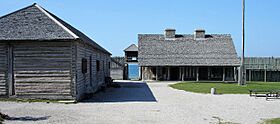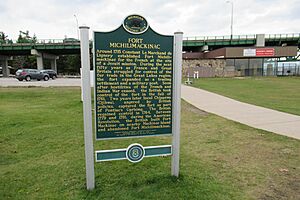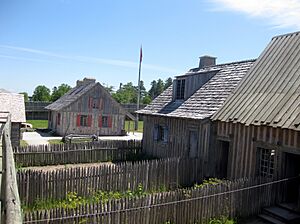Fort Michilimackinac facts for kids
|
Fort Michilimackinac
|
|
 |
|
| Location | Near Mackinac Bridge, Mackinaw City, Michigan |
|---|---|
| Built | 1715 |
| NRHP reference No. | 66000395 |
Quick facts for kids Significant dates |
|
| Added to NRHP | October 15, 1966 |
| Designated NHL | October 9, 1960 |
| Colonial Michilimackinac Historic State Park |
|
|---|---|
 |
|
| Lua error in Module:Location_map at line 420: attempt to index field 'wikibase' (a nil value). | |
| Location | Wawatam Township, Emmet County, Michigan, United States |
| Area | 37 acres (15 ha) |
| Administered by | Michigan Department of Natural Resources |
| Designation | Michigan state park |
Fort Michilimackinac was an old fort and trading post from the 1700s. It was first built by the French and later used by the British. The fort was located in what is now Mackinaw City, Michigan, at the very top of Michigan's lower peninsula.
It was built around 1715 and closed in 1783. The fort sat along the Straits of Mackinac, which is a narrow waterway connecting Lake Huron and Lake Michigan. Today, you can visit a reconstructed version of the fort. It is the main part of the Colonial Michilimackinac Historic State Park.
The modern town of Mackinaw City grew up around where the fort used to be. The fort site is now a special National Historic Landmark. It's like an outdoor museum with rebuilt wooden buildings and tall fences called palisades.
Contents
Fort Michilimackinac's Story
The main reason the French built Fort Michilimackinac was to be a part of their large trading post network. This network helped them trade goods like furs all the way from the Atlantic Ocean to the Great Lakes and down the Mississippi River. The fort was a key place to get supplies for traders working in the western Great Lakes area.
The French first came to the Straits of Mackinac in 1671. A priest named Father Marquette started a mission called St. Ignace Mission in what is now St. Ignace, Michigan. In 1683, they added a fort there called Fort de Buade. But in 1701, a French leader named Sieur de Cadillac moved the soldiers to Fort Detroit and closed the mission.
Rebuilding the French Presence
By 1713, the French decided they needed to be back at the Straits of Mackinac. So, in 1715, they built the wooden Fort Michilimackinac on the northern tip of the lower peninsula. They sent soldiers and workers to build it. Over many years, they made the fort's walls bigger and stronger. A French officer named Jacques Testard de Montigny was in charge of the fort for three years starting in 1730.
British Take Control
In 1761, the French lost the fort to the British. This happened after a big war called the French and Indian War (also known as the Seven Years' War). Even though the British were in charge, most people living at the fort were still French or Métis (people with both French and Ojibwe heritage). They mostly spoke French and went to the Sainte Anne Church inside the fort. Some British fur traders also lived there.
Ojibwe Uprising and the Lacrosse Trick
The Ojibwe people in the area soon became unhappy with the British. The British stopped giving them gifts every year, which was a tradition the French had followed. On June 2, 1763, as part of a larger conflict called Pontiac's War, a group of Ojibwe warriors used a clever trick. They played a game of baaga'adowe (an old game similar to lacrosse) right outside the fort.
This game was a trick to get inside the fort. Once they were in, they surprised the British. Many British soldiers and traders were captured or killed. The Ojibwe held the fort for about a year. Then, the British got control back by promising to give more and better gifts to the Native American people.
Moving to Mackinac Island
Eventually, the British decided that the wooden fort on the mainland was too easy to attack. In 1781, they built a new fort made of limestone on nearby Mackinac Island. This new fort is now called Fort Mackinac.
Over the next two years, the British carefully moved many of the buildings from the old fort to the island. They took them apart and moved them across the water in summer or over the ice in winter. Even Ste. Anne's Church was moved. After everything was moved, the British leader ordered the old Fort Michilimackinac to be burned down.
Digging Up the Past: Archaeology and Reconstruction
In 1933, the fort's outer fence (palisade) was rebuilt, and a small museum opened.
Real archaeological digs at the fort began in the summer of 1959. Experts from Michigan State University started working there, and these digs have continued every summer since. The palisade rebuilt in 1933 was taken down in 1960. Then, based on what archaeologists found, the fort began to be rebuilt more accurately.
From 1970 to 1973, archaeologists looked outside the fort walls and found three old houses. After that, they returned to digging inside the fort.
For some years, workers at the site included inmates from a corrections camp. Today, the archaeology teams have both paid staff and volunteers.
As of 2024, archaeologists have found signs of at least 40 buildings inside the fort walls. About 65% of these have been rebuilt. Here are some of the buildings that have been dug up and reconstructed:
- King's Storehouse – dug up between 1959 and 1966, rebuilt between 1959 and 1969
- Priest's House – dug up between 1959 and 1966, rebuilt between 1959 and 1969
- Church of Ste. Anne – dug up between 1959 and 1966, rebuilt between 1959 and 1969
- Soldiers' Barracks – dug up between 1959 and 1966, rebuilt between 1959 and 1969
- Guardhouse
- Military Latrine (an old toilet building)
- Blacksmith Shop
- Powder Magazine (where gunpowder was stored) – dug up from 1974 and into 1977
- Commanding Officer's House
- Northwest Rowhouse
- Southwest Rowhouse
- Southeast Rowhouse – partly dug up in the 1970s and still being explored, partly rebuilt
- South Southeast Rowhouse – partly dug up in the 1970s
- South Southwest Rowhouse – partly dug up in the 1960s and again from 1998 to 2007, rebuilt in 2013
Visiting Fort Michilimackinac Today
In 1960, the fort area was named a National Historic Landmark. The site was then restored, mostly by rebuilding structures based on archaeological findings. This made it a popular place for visitors.
Today, the fort and its grounds are part of Colonial Michilimackinac Historic State Park in Mackinaw City. This park is a big part of the Mackinac State Historic Parks. People called "interpreters" (both paid staff and volunteers) help bring history to life. They do this with music, live demonstrations, and reenactments, including showing how muskets and cannons were fired.
Fort Michilimackinac is known as one of the most thoroughly dug-up early French colonial archaeological sites in the United States.
The state park also includes the base of the Mackinac Bridge, the Old Mackinac Point Lighthouse (built in 1892), and a park area with great views of the Mackinac Bridge and Mackinac Island. There's also a visitor center and gift shop.
See also
- Banknote of Fort Michilmackinac
- List of National Historic Landmarks in Michigan
- National Register of Historic Places listings in Emmet County, Michigan



